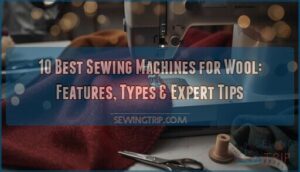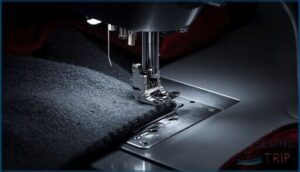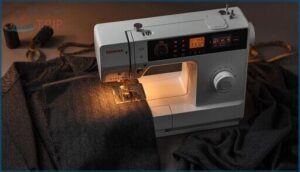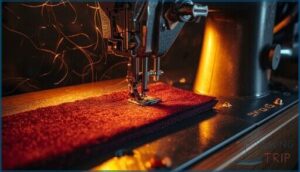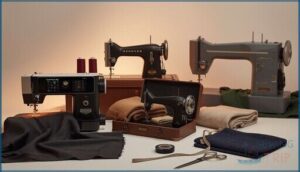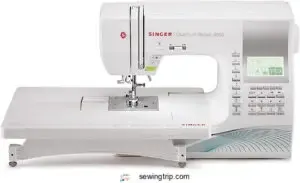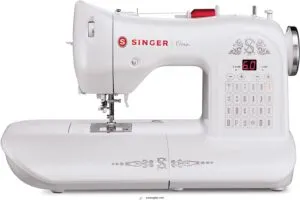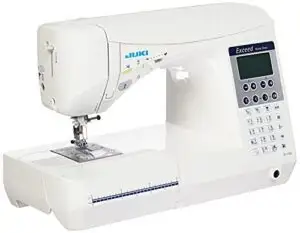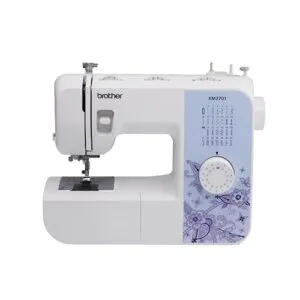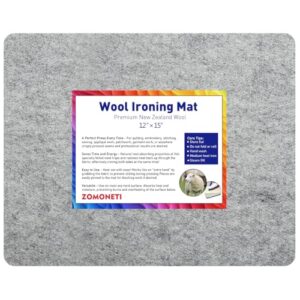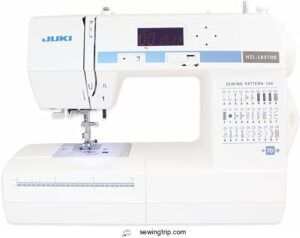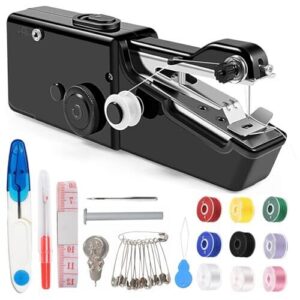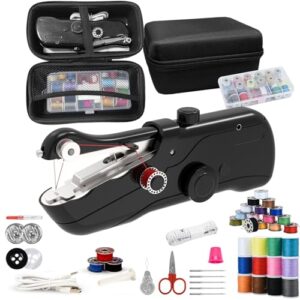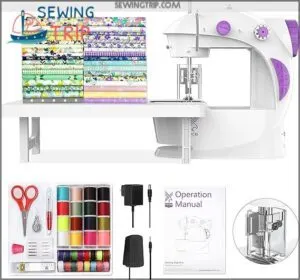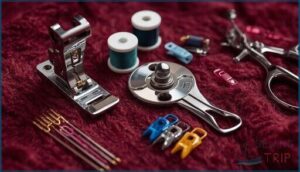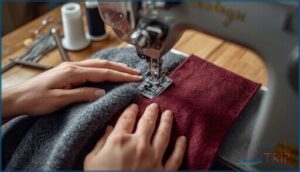This site is supported by our readers. We may earn a commission, at no cost to you, if you purchase through links.
Wool’s dense fibers and unpredictable stretch turn most home sewing machines into frustrating paper weights. You’ll feed a coat panel through the presser foot only to watch the fabric bunch, the needle snap, or the motor groan under pressure. The problem isn’t your skill—it’s machine capability.
Standard models lack the high presser foot lift needed to accommodate multiple wool layers, and their weak feed systems can’t grip the fabric’s slippery surface. You need a machine built for thick materials: one with adjustable presser foot pressure, a sturdy feed mechanism, and enough motor power to penetrate wool’s density without hesitation.
The right equipment transforms wool from a nightmare fabric into a dream project, letting you construct fitted coats and structured garments with professional-grade seams.
Table Of Contents
- Key Features for Sewing Wool Fabrics
- Types of Sewing Machines Suitable for Wool
- Top 10 Sewing Machines for Wool
- 1. Singer Quantum Stylist Sewing Machine
- 2. Singer One Sewing Machine
- 3. Juki Sewing And Quilting Machine
- 4. Brother Lightweight Sewing Machine Model
- 5. Zomoneti Wool Pressing Mat
- 6. Bearfire Portable Handheld Sewing Machine
- 7. Juki Computerized Sewing Machine
- 8. Mini Handheld Sewing Machine
- 9. Portable Handheld Sewing Machine Kit
- 10. Mini Sewing Machine For Beginners
- Essential Accessories for Wool Sewing
- Tips for Sewing Wool Without Issues
- Maintenance and Care for Wool Sewing Machines
- Frequently Asked Questions (FAQs)
- Conclusion
Key Features for Sewing Wool Fabrics
Sewing wool isn’t like working with cotton or polyester—you need a machine built to handle the challenge. The right features make all the difference between smooth stitching and constant frustration with thick, textured fabrics.
Here are the key capabilities your sewing machine needs to conquer wool projects with confidence.
High Presser Foot Lifter and Box Feed
You’ll conquer thick wool layers when your machine pairs a high presser foot lifter with box feed technology. The high lift clears several extra millimeters under the presser foot, giving bulky seams room to glide through without bunching.
A high presser foot lifter with box feed technology gives thick wool layers the clearance they need to glide through without bunching
Meanwhile, the box feed mechanism stabilizes fabric movement behind the needle plate, preventing those frustrating shifts that plague wool’s textured surface and ensuring your feed system delivers consistent, skip-free stitches.
To maintain academic integrity in sewing guides, authors must follow proper citation style rules.
Automatic Needle Threader and Reverse Function
Your thread management gets easier once you’ve got auto threading and reverse stitching in one package. An automatic needle threader cuts your setup time by 50 percent, even with thick wool fibers that resist manual alignment.
The reverse function lets you lock seams at each end with a quick lever press, reinforcing edges that would otherwise fray under wool’s weight and preventing unraveling on stress points.
Proper documentation of sewing techniques requires understanding of technical writing styles to effectively communicate complex information.
Adjustable Speed and Multiple Stitch Patterns
You’ll want speed control that lets you dial down to 200 stitches per minute when managing wool’s thickness, then ramp up for straight seams.
Stitch variety matters—12 built-in patterns give you zigzag for stretch prevention and straight stitches for crisp hems.
Pattern customization and fabric compatibility transform your portable sewing machine into a precision sewing tool that adjusts to medium and heavy wool without hesitation.
Durability and Safety Features for Thick Fabrics
Machine durability starts with a steel frame that keeps vibration in check when you’re pushing heavy wool layers through. High presser foot lifter clearance and box feed technology prevent jams, while an automatic needle threader saves your fingers from thick thread wrestling.
Safety mechanisms like needle-penetration control and emergency stops protect you during fabric thickness changes, and reinforced feed dogs resist deformation under heavy-duty materials.
Types of Sewing Machines Suitable for Wool
You’ll find sewing machines for wool across several categories, each designed to handle different project scales and skill levels. Computerized models offer precision control for complex garment work, while mechanical machines deliver reliable performance without digital complexity.
From industrial-grade workhorses to compact portables that fit in your travel bag, the right machine type depends on your workspace, budget, and how often you work with heavy fabrics.
Computerized Vs. Mechanical Models
Choosing between computerized controls and mechanical reliability shapes your wool fabric sewing experience. Computerized models deliver automated threading and memory for electronic stitches, while mechanical sewing machines emphasize straightforward maintenance with manually adjustable stitch selectors.
- Computerized systems: Digital interface with automatic needle up/down and tension adjustments
- Mechanical models: Fewer electronic components mean simpler troubleshooting
- Performance edge: Computerized sewing machine features include error diagnostics for thick wool projects
Industrial and Quilting Machines
High-speed operation defines industrial sewing when you’re working with dense wool. Motor power and sturdy machine frames let you tackle heavy-duty materials without skipped stitches, while quilting machines like the JUKI HZLF300 offer extended harp spaces and arm length for layered wool projects.
Feed systems with walking feet keep your fabric advancing consistently, preventing the slippage that ruins wool garments.
Portable and Handheld Options
You’ll find freedom with portable sewing machines weighing under 10 pounds and handheld mini sewing machines for quick wool repairs. Battery-powered handheld devices deliver cord-free convenience, while travel sewing setups fit right into your hobby bag. These compact machines suit light wool projects and alterations:
- Weighs 0.5–10 pounds for easy transport between locations
- USB or AA battery power facilitates on-the-go wool sewing projects
- Walking foot upgrades improve fabric feed on portable kits
- Needle sizes 80/12 to 90/14 handle medium-weight wool blends
- Portable handheld units include automatic overload protection circuits
Beginner-Friendly Sewing Machine Sets
You’ll gain confidence with beginner sewing machine kits that bundle compact designs, user manuals, and accessory bundles customized for wool sewing projects. These portable sewing machine sets include beginner tutorials and warranties spanning 1–5 years. Sewing machine reviews highlight simplified stitch selection and walking foot attachments.
| Feature | Benefit |
|---|---|
| Mechanical operation | Reduces confusion during learning |
| Bundled accessories | Immediate wool-compatible needle access |
| Stable metal frames | Prevents wobble on thick fabrics |
Top 10 Sewing Machines for Wool
You need a machine that won’t buckle under the weight and texture of wool fabrics. The right sewing machine manages thick weaves without jamming, offers precise stitch control, and includes features that make wool projects manageable from start to finish.
Here are ten machines and accessories that deliver the performance you’re looking for.
1. Singer Quantum Stylist Sewing Machine
The Singer Quantum Stylist combines 600 built-in stitches with a durable metal frame that won’t flex when you’re pushing thick wool layers through. You’ll appreciate the automatic needle threader and adjustable presser foot pressure—two features that prevent puckering on medium-weight wool fabrics.
It manages multi-layer wool sewing projects with a high presser foot lift and includes 13 presser feet for various wool sewing techniques.
At $538.14, this machine delivers consistent sewing performance for quilting and tailoring without the commercial-grade price tag.
| Best For | Sewers who work with wool fabrics and need a reliable machine that handles thick layers, offers adjustable pressure settings, and provides enough stitch variety for tailoring and quilting projects. |
|---|---|
| Price Range | $538.14 |
| Weight | 14.6 lbs |
| Built-in Stitches | 600 stitches |
| Automatic Threader | Yes |
| Power Source | Electric (120V) |
| Portability | Medium |
| Additional Features |
|
- 600 stitches and adjustable presser foot pressure give you control over wool’s tricky texture and prevent puckering
- Metal frame stays stable when pushing dense wool through, plus the high presser foot lift handles multiple layers without fighting you
- Comes with 13 presser feet right out of the box, so you can tackle different wool techniques without buying extras
- The throat plate might feel cramped if you’re working on larger quilting projects with bulky wool
- Takes some time to learn all the features—you’ll probably need to keep the manual handy at first
- Stitching quality can be inconsistent according to some users, which might require tweaking settings for different wool weights
2. Singer One Sewing Machine
You’ll find everything you need for straightforward wool sewing projects in the Singer One Sewing Machine. This mechanical model features 24 built-in stitches and an extra-large sewing space (14.7 inches) that accommodates bulky wool layers without cramping your hands.
The automatic needle threader eliminates squinting, while the drop-and-sew bobbin system simplifies thread management between color changes. Its high presser foot lifter clears thick wool fabrics, and the metal frame construction prevents flexing during heavy-duty materials work—all at a beginner-friendly price point of under $200.
| Best For | Beginners and home sewers who need a reliable machine for wool projects without complicated features or a steep learning curve. |
|---|---|
| Price Range | $200-300 |
| Weight | 23.9 lbs |
| Built-in Stitches | 24 stitches |
| Automatic Threader | Yes |
| Power Source | Electric |
| Portability | Low |
| Additional Features |
|
- Extra-large sewing space (14.7 inches) handles bulky wool layers and larger projects like quilts or home décor items comfortably.
- Automatic needle threader and drop-and-sew bobbin system cut down setup time and make threading hassle-free.
- Metal frame construction keeps the machine stable when working through thick wool fabrics and multiple layers.
- Some users report threading accuracy issues and occasional computer glitches that can disrupt workflow.
- Noise levels vary by unit—while some find it quiet, others describe it as noticeably loud during operation.
- Limited decorative stitches (24 total) and no hard case included, just a thin plastic dust cover for protection.
3. Juki Sewing And Quilting Machine
Your wool projects deserve the precision of the Juki HZL-F300, a machine built to power through multi-layer wool batches without hesitation. Its metal frame construction delivers machine durability that prevents flexing when you’re stitching thick fabrics, while 106 stitch patterns give you creative freedom for quilting and embroidery work.
The box feed system keeps dense wool moving evenly under the needle—no bunching or puckering. The automatic needle threader and push-button reverse save you time on seam reinforcement, making this a smart choice for serious wool sewing.
| Best For | Intermediate sewers and quilters who regularly work with thick wool fabrics and want a durable machine that can handle multi-layer projects without skipping stitches. |
|---|---|
| Price Range | $300-400 |
| Weight | 25 lbs |
| Built-in Stitches | 106 stitches |
| Automatic Threader | Yes |
| Power Source | Electric (120V) |
| Portability | Medium |
| Additional Features |
|
- Metal frame construction prevents flexing during heavy-duty wool sewing, keeping stitches consistent even through multiple layers
- Box feed system moves dense wool smoothly without bunching, plus the automatic needle threader saves time on setup
- 106 stitch patterns and 16 buttonhole styles give you plenty of creative options for both functional seams and decorative quilting
- Missing some helpful accessories out of the box—no walking foot, free motion foot, or knee lever included (you’ll need to buy these separately)
- Fewer stitch options than higher-end Juki models like the HZL-600, so advanced sewers might outgrow it
- Only works with 120V electricity, so you’ll need a converter if you’re in a country that uses 240V power
4. Brother Lightweight Sewing Machine Model
You’ll appreciate the Brother XM2701S when storage space and machine portability matter. Weighing just 12.6 pounds, this portable sewing machine tucks into closets and travels easily to workshops.
It delivers 27 built-in stitches—including zigzag and stretch options—that handle medium-weight wool without skipping. The automatic needle threader and drop-in bobbin simplify setup, while the free arm manages wool cuffs and sleeves.
At $129.99, it’s a practical entry point for wool compatibility, though stitch quality can falter on heavier fabrics. Maintenance costs stay low with accessible replacement parts.
| Best For | Beginners and hobbyists who need a portable, budget-friendly machine for light to medium-weight wool projects and don’t plan to tackle heavy fabrics. |
|---|---|
| Price Range | $129.99 |
| Weight | 12.6 lbs |
| Built-in Stitches | 27 stitches |
| Automatic Threader | Yes |
| Power Source | Electric |
| Portability | High |
| Additional Features |
|
- Weighs only 12.6 pounds and fits easily into closets or travel bags for workshops and classes
- 27 built-in stitches including zigzag and stretch options work well with medium-weight wool
- Automatic needle threader and drop-in bobbin make setup quick and frustration-free
- Stitch quality can be inconsistent, with some users reporting skipped stitches on thicker fabrics
- Plastic spool pin may break with frequent use or heavier thread
- Not powerful enough for dense or heavy wool fabrics that require industrial-strength stitching
5. Zomoneti Wool Pressing Mat
Your wool projects deserve more than a standard sewing machine—they need proper pressing equipment. The ZOMONETI Wool Pressing Mat transforms how you handle fabric care and maintenance between stitches.
At 15” x 12” with 1/2-inch thickness, this 100% New Zealand wool surface absorbs heat up to 200°C while you work both fabric sides simultaneously. Its felted texture grips material without distortion, making ironing and pressing techniques more precise.
You’ll flatten seams on small quilt blocks and fat quarters directly on your worktable. Just store it flat and completely dry to maintain performance across projects.
| Best For | Quilters and sewists working with wool fabrics who need precise seam pressing and portable ironing for small-scale projects. |
|---|---|
| Price Range | $30-40 |
| Weight | Not specified |
| Built-in Stitches | N/A |
| Automatic Threader | N/A |
| Power Source | N/A |
| Portability | High |
| Additional Features |
|
- Felted New Zealand wool texture grips fabric to prevent stretching and allows you to press both sides simultaneously
- Compact 15” x 12” size works on any hard surface, making it ideal for small quilt blocks and fat quarters
- Heat-resistant up to 200°C so you can use higher iron temperatures without scorching wool fibers
- Temperature limit of 200°C may restrict use with certain high-heat fabric treatments
- Cannot be machine washed and requires flat storage, which limits cleaning options and storage flexibility
- Steam ironing requires an additional protective layer underneath the mat to prevent damage
6. Bearfire Portable Handheld Sewing Machine
You need repairs on the go, and the Bearfire Portable Handheld Sewing Machine delivers that freedom. This beginner sewing machine weighs just 12.3 ounces—light enough to toss in your bag for quick wool fixes anywhere.
Its handheld mini sewing machine design manages fabrics up to 1.5mm thick, perfect for lighter wool repairs and hems. Battery life runs on 4 AA batteries or USB power, giving you flexibility without outlets.
The compact storage format includes mini accessories in a carrying case, making portable sewing machines like this ideal for travel and emergency mending.
| Best For | Travelers, beginners, and anyone who needs quick wool repairs or light sewing projects on the go without lugging around a full-size machine. |
|---|---|
| Price Range | $15-25 |
| Weight | 12.3 oz |
| Built-in Stitches | Basic stitch |
| Automatic Threader | No |
| Power Source | Battery/USB |
| Portability | High |
| Additional Features |
|
- Super portable at just 12.3 ounces, so you can handle wool mending anywhere without being tied to a table or outlet.
- Dual power options with batteries or USB mean you’re never stuck without a way to sew, whether you’re at home or traveling.
- Comes with a complete kit and storage bag, making it genuinely ready to use right out of the box.
- Struggles with thicker wool layers or multiple fabric stacks, so heavy wool projects will need a sturdier machine.
- Limited throat depth means you can’t handle bulky garments or large sewing areas easily.
- Batteries aren’t included, and runtime is short, so longer projects might leave you frustrated.
7. Juki Computerized Sewing Machine
You master wool projects when precision matters, and the Juki HZL-LB5100 computerized sewing machine delivers that control. This Juki model features 100 built-in stitches and programmable stitch length adjustments, giving you sewing precision on thick wool layers without puckering.
Machine durability shows in its aluminum frame and 12.32-pound construction. Wool compatibility improves through adjustable thread tension and memorized needle up/down positioning.
Sewing machine reviews highlight its quiet operation and consistent feed on textured fabrics. At 15.98 x 7.17 x 11.73 inches, it balances portability with the stability computerized stitches demand for professional wool garment construction.
| Best For | Sewers who need reliable stitch control and precision for wool garments, quilting projects, and fabrics that demand consistent tension and feed. |
|---|---|
| Price Range | $200-300 |
| Weight | 12.32 lbs |
| Built-in Stitches | 100 stitches |
| Automatic Threader | Yes |
| Power Source | Electric |
| Portability | High |
| Additional Features |
|
- 100 built-in stitches with programmable length and width let you dial in the exact settings wool needs to avoid puckering or stretching.
- Aluminum frame and sturdy construction keep stitches stable on thick wool layers while staying portable enough for classes or retreats.
- Quiet operation and adjustable tension handle wool’s texture variations smoothly, whether you’re topstitching coats or piecing wool quilts.
- Struggles with very thick materials like heavy denim, so multiple layers of dense wool might push its limits.
- Learning curve takes time to master all the stitch options and settings, especially if you’re new to computerized machines.
- You’ll likely need to buy extra feet or accessories separately for specialized wool work like walking feet for even feeding.
8. Mini Handheld Sewing Machine
You’ll find the handheld mini sewing machine weighs under 2 pounds and runs on battery or USB power, making its portable design ideal for quick wool repairs rather than full garment construction.
This mini machine performs best on lightweight wool blends using needles sized 70/10 to 90/14. Handheld sewing offers convenience for small-scale tasks, though sewing accuracy decreases on thick wool layers due to limited feed capability.
The beginner sewing machine includes a basic sewing kit with a needle threader, but its modest motor torque restricts wool capability to simple repairs on light fabrics.
| Best For | People who need a lightweight, portable solution for quick wool repairs and small-scale sewing tasks on light fabrics while traveling or away from home. |
|---|---|
| Price Range | $15-25 |
| Weight | 10.8 oz |
| Built-in Stitches | Basic stitch |
| Automatic Threader | No |
| Power Source | Battery |
| Portability | High |
| Additional Features |
|
- Weighs under 2 pounds and runs on battery or USB power, making it easy to carry anywhere for on-the-go repairs
- Includes helpful features like a needle threader and works with standard needles sized 70/10 to 90/14 for different wool weights
- Budget-friendly option that handles simple wool blend repairs without requiring a full-size machine
- Limited motor torque and feed capability make it unreliable for thick wool layers or continuous seams
- Not suitable for heavy wool projects or full garment construction due to modest power and stability issues
- Produces less accurate stitching on curves or thick fabrics, with higher noise levels than standard machines
9. Portable Handheld Sewing Machine Kit
Portable handheld sewing machine kits deliver compact storage and convenient fabric handling for quick wool repairs on the go. You’ll find these handheld devices run on battery power, offering up to 2 hours of continuous operation with variable speed from 300 to 700 stitches per minute.
The beginner sewing machine includes a basic sewing kit with needles, bobbins, and USB charging cable.
While portability makes these mini sewing tools practical for lightweight wool blends, their limited motor capacity restricts performance on thick wool fabrics requiring industrial-grade tension control.
| Best For | Beginners and craft enthusiasts who need a portable solution for quick mending, light wool repairs, and small sewing projects on fabrics like cotton, denim, and lightweight wool blends. |
|---|---|
| Price Range | $25-35 |
| Weight | 1.68 lbs |
| Built-in Stitches | Basic stitch |
| Automatic Threader | No |
| Power Source | Battery/Electric |
| Portability | High |
| Additional Features |
|
- Dual power options with up to 2 hours of battery life let you sew anywhere without being tied to an outlet
- Complete starter kit includes everything you need—scissors, threads, needles, ruler, and a storage case for easy organization
- Two speed modes (300-700 stitches per minute) give you control whether you’re working on delicate repairs or heavier fabrics
- Durability concerns with some users reporting the machine breaks easily or stops stitching unexpectedly
- Lacks a safety lock switch and may struggle with consistent stitch tightness on thicker materials
- Instructions can be unclear or hard to read, making setup frustrating for first-time users
10. Mini Sewing Machine For Beginners
The KPCB Tech mini sewing machine for beginners weighs under 5 pounds and features a compact design suited for light wool blends. You’ll appreciate its user interface with slow and standard sewing speeds, finger guard for safety, and double-thread construction.
This beginner sewing machine includes sewing machine accessories like bobbins, scissors, and needles—essential sewing kit essentials for starting out. While the handheld mini sewing machine manages basic wool repairs, you’ll encounter limitations with thick wool layers.
Follow beginner sewing tips: use 90/14 needles and adjust presser foot tension for best results.
| Best For | Beginners and kids learning basic sewing skills who want a lightweight, portable machine for simple projects like small repairs, patchwork, and working with light to medium fabrics including wool blends. |
|---|---|
| Price Range | $39.99 |
| Weight | Not specified |
| Built-in Stitches | Basic stitch |
| Automatic Threader | Yes (needle threader included) |
| Power Source | Electric |
| Portability | Medium |
| Additional Features |
|
- Comes with a complete starter kit including bobbins, scissors, measuring tape, needles, fabric bundles, and tutorial videos so you can start sewing right away
- Compact and lightweight design under 5 pounds makes it easy to move around, store, and use in small spaces
- Safety features like a finger guard and adjustable speeds make it suitable for beginners and kids learning to sew
- Mixed reviews on reliability with some users reporting issues like broken foot pedals, machines breaking after short use, and inconsistent stitching quality
- Limited to basic sewing tasks and struggles with thick fabrics or multiple layers—not suitable for complex projects or heavy-duty materials like thick wool
- Can feel too basic and flimsy for anyone wanting to progress beyond simple repairs and crafts
Essential Accessories for Wool Sewing
You’ll need more than just a great sewing machine to tackle wool projects with confidence. The right accessories make all the difference when working with thick, textured fabrics that demand specialized tools.
Here’s what belongs in your wool sewing toolkit to guarantee smooth stitches and professional results every time.
Wool Pressing Mats and Their Benefits
A wool pressing mat transforms your finishing work by distributing heat evenly across thick fibers, preventing scorching while you achieve crisp seams.
The ZOMONETI Wool Pressing Mat features heat-resistant materials that protect delicate wool weaving and boost ironing efficiency through excellent thermal retention. Its non-slip surface guards fabric from sticking during pressing techniques, and built-in grid markings guarantee accurate alignment—essential additions to any serious sewing kit.
Needle and Thread Selection for Wool
You can’t push wool through a machine without the right needle sharpness and wool thread types—mismatched tools cause puckering and broken stitches. Match needle type to fabric grain and adjust thread tension for clean seams. Your sewing machine needs threading ability and fabric compatibility to handle wool’s density.
Master these sewing techniques:
- Use sharp universal needles (70/10 to 90/14) based on wool weight
- Select polyester or cotton-wrapped polyester threads for strength
- Set moderate stitch length (2.5–3.0 mm) for stability
- Test needle and thread compatibility on scrap fabric first
- Replace dull needles immediately to prevent fiber fraying
Walking Foot and Feed Foot Attachments
After selecting your needle and thread, attachment compatibility becomes your next checkpoint. Both presser feet work with most home machines that have low shank compatibility, broadening your heavy duty materials handling options.
A walking foot travels in sync with fabric layers, preventing shifting on thick wool through its feed mechanism. Feed feet provide multi-directional fabric guidance for slippery materials.
| Attachment Type | Primary Function | Best Wool Application |
|---|---|---|
| Walking Foot | Synchronized top feed with feed dogs | Thick, layered wool projects |
| Feed Foot | Multi-directional fabric guidance | Slippery or bulky wool weaves |
| Universal Presser Feet | Standard fabric advancement | Lightweight wool garments |
| Roller Foot | Prevents fabric sticking | Textured wool surfaces |
| Teflon Foot | Smooth gliding over dense fibers | Heavy wool coats and blankets |
Proper foot calibration requires slower stitch speeds and testing on scrap wool to adjust feed pressure and alignment before final seams. You’ll need to verify attachment compatibility with your sewing machine model—check foot width and shank style to maintain stitch regulation on wool. Some wool projects benefit from slightly longer stitch length to reduce fabric compression and improve seam integrity.
Storage and Portability Solutions
Once you’ve secured the right foot attachment, protecting your sewing machine during transport becomes your next priority. Compact portable designs weighing under 15 pounds fit in padded storage cases with moisture barriers and collapsible fabric covers for long-term protection.
- Rolling carry cases with compartments safeguard machines up to 25 pounds
- Built-in grips enable one-person lifting for workshop rotation
- Magnetic accessory trays keep needles secured during machine transport
- Foldable dollies reduce back strain in small studios
Tips for Sewing Wool Without Issues
Wool’s thick fibers and textured surface demand specific techniques to prevent frustration at the machine. You’ll need to adjust needle size, stitch length, and presser foot tension to match wool’s unique properties.
Here’s how to set up your machine and handle wool fabrics without jams, breaks, or distortion.
Choosing The Right Needle Size and Type
You’ll want needles between 80/12 and 100/16 for most wool projects—larger sizes handle heavy fabric density without thread breaks. Ballpoint needles prevent snagging on knits, while sharp needles deliver clean seams on woven worsteds.
Match your thread weight to needle material for consistent penetration. Test on scrap fabric first, then swap needles every eight hours to maintain sewing machine performance and avoid costly mistakes.
Stitch Settings for Wool Fabrics
Set your stitch length to 2.0–2.5 mm for balanced seam integrity without puckering delicate wool edges. A straight stitch offers the best fabric stability on woven wool, while a narrow zigzag prevents fraying along raw edges.
Keep thread tension at factory defaults unless you notice fabric shifts—then adjust by small increments.
Test stitch density on scrap fabric to confirm your sewing machine settings before tackling your final project.
Preventing Jams and Needle Breakage
Three factors cause 90% of needle breakage and jams when you’re sewing wool: incorrect needle selection, poor thread tension, and inadequate fabric preparation. Your sewing machine demands proper calibration to handle wool’s density without compromising needlework precision or sewing machine safety.
- Install universal needles sized 90/14 for medium wool or 110/18 for heavyweight weaves
- Check your needle isn’t bent before threading—even slight warping triggers breakage prevention issues
- Balance thread tension to prevent skipped stitches and fabric bunching during seams
- Clear lint from the feed dogs after every project to maintain smooth weaving action
- Use sharp, polished needles designed for woven textiles to reduce snagging resistance
Using The Proper Presser Foot Tension
Presser foot adjustment directly controls fabric feed quality on thick wool layers. Your sewing machine requires medium to high pressure settings to prevent shifting, but excessive tension causes stretching and tunneling along seams.
Test pressure settings on scrap wool before starting your project—proper tension control delivers consistent stitch length and prevents puckering. Walking presser feet improve seam quality by distributing pressure evenly across textured weaves.
Maintenance and Care for Wool Sewing Machines
Your sewing machine works hard when handling thick wool fabrics, so keeping it in top condition isn’t optional—it’s essential.
Regular maintenance prevents breakdowns, extends your machine’s lifespan, and ensures consistent stitch quality on every project.
Here’s what you need to do to keep your wool-sewing workhorse running smoothly.
Regular Cleaning and Oiling
Think of machine lubrication as your weapon against wool lint buildup. You’ll want to apply light, non-detergent oil to moveable metal parts every 8–12 hours of use, following your manual’s recommendations. Keep a maintenance log to track cleaning schedules and sewing machine tuneups.
Here’s your core routine:
- Clear lint from feed dogs and bobbin area after each project
- Oil the hook race and needle bar at manufacturer intervals
- Wipe surplus oil immediately to prevent fabric staining
Replacing Needles and Threads
A dull needle causes fabric snagging and thread breakage faster than you’d expect. You’ll need to replace needles after every 8 hours of wool sewing or when switching projects. Size 80/12 to 90/14 needles work best for medium-weight wool.
Check needle alignment regularly—misalignment creates stitch tension problems and skipped stitches. Match thread weight to fabric density for ideal sewing machine maintenance.
Proper Storage and Transport
Your sewing machine needs a padded case with rigid walls to protect against impact damage during transport. Keep it upright to prevent oil leakage and store in a stable environment between 60 and 80 degrees Fahrenheit. Cover with breathable fabric to reduce dust accumulation while allowing airflow.
Detach sewing accessories and coil cords separately—proper storage environment control prevents rust and maintains sewing machine performance between projects.
Professional Servicing and Troubleshooting
You’ll need manufacturer-recommended service intervals—usually every 12 months for moderate use or after 100 hours with thick wool fabrics. Schedule inspections with certified technicians who understand heavy-fabric diagnostics.
Proper troubleshooting steps include checking tension benchmarks and feed timing. Keep maintenance records for warranty coverage.
Quality diagnostic tools identify issues before they escalate, protecting your sewing machine investment and ensuring consistent performance with challenging materials.
Frequently Asked Questions (FAQs)
What type of needle is best for sewing wool fabric?
You’ll want a sharp, universal needle sized 80/12 to 90/14 for most wool fabrics. Ballpoint needles work better on wool blends with stretch, while heavier wools demand 100/16 for consistent stitch formation.
How can I prevent wool fabric from stretching as I sew?
Pre-wash and dry press your wool flat, then pin every inch to prevent creep. Lower your sewing machine speed, use 0–5 mm stitches, and apply wool stabilizers for seam reinforcement.
What tension setting should I use when sewing with wool fabric?
Getting it right the first time saves hours of seam ripping.
Start your sewing machine tension between 0–0 for balanced stitch options on medium-weight wool, adjusting by fabric weight and needle size for perfect stitch balance.
Can I sew wool blends with cotton machines?
You can sew wool blends with cotton machines by switching to an 80/12 to 90/14 needle, adjusting stitch length to 5–0 mm, and adding a walking foot for consistent fabric compatibility.
How do I prevent wool from stretching?
You’ll feel like wool grows before your eyes if tension isn’t controlled.
Use a sharp needle, balanced stitch length, and light presser foot pressure—plus steam management and fabric stabilization—to prevent stretching during heavy-duty materials sewing.
Whats the best way to finish wool seams?
You’ll get the cleanest results with overlock stitches or bound edges on raw seam allowances. For delicate wool crepe, try French seams.
Use your sewing machine’s walking foot to prevent shifting during garment construction.
Do I need a special bobbin for wool?
You don’t need a special bobbin for wool. Standard metal or plastic bobbins work fine when you adjust bobbin thread tension and match thread weight to your fabric’s thickness and texture.
How do I remove lint from wool fabrics?
You’ll tackle lint removal with a wool-safe fabric brushing tool or adhesive lint roller after each wear.
Preventive fiber management includes hand washing in cold water, air drying flat, and storing wool garments separately from cotton to minimize lint accumulation.
Conclusion
Like a sculptor choosing between a butter knife and a chisel, your fabric demands the right tool. The best sewing machine for wool doesn’t fight the material—it commands it with high presser foot lift, adjustable tension, and motor power that penetrates dense fibers without hesitation.
You’ve seen the specs, the models, the accessories. Now stop wrestling with inadequate equipment. Invest in a machine that transforms wool from obstacle into opportunity, and watch your garments earn the finish they deserve.
- https://onlinepubs.trb.org/onlinepubs/nchrp/cd-22/manual/v1appendixb.pdf
- https://academichelpexpress.blog/2024/08/please-use-the-bulleted-points-and-the-rubric-below-to-guide-your-work-your-pa/
- https://www.linkedin.com/posts/bohdanlukianets_tasks-study-research-activity-7373377539521667072-UTEi
- https://www.writingclearscience.com.au/category/writing-guides/writing-research-papers/page/2/
- https://www.sciencedirect.com/science/article/pii/S0749208123000268

